Laser Diode: Construction, Working, Types, Advantages, Disadvantages & Applications
Laser diode similar to LED is used for producing light but the light is coherent and focused at a small point. It was invented by American physicist Theodore H. Maiman. It is extensively used in fiber optical communication, bar code reader, laser printing and scanning, etc.
What is a Laser Diode?
The word LASER stands for Light Amplification by Stimulated Emission of Radiation. It is a semiconductor-based PN junction device that converts electrical energy into light energy similar to LED. It generates a high-intensity coherent and monochromatic light (single color).
The emitted radiations have the same frequency and phase or sometimes very narrow bandwidth. It is used in high-speed optical fiber communication.
It operates similar to LED except for the PN junction high power light due to Stimulated Emission of light. An incident photon strikes the semiconductor atom generating two photons resulting in a high power beam.
Symbol of Laser Diode
The symbol of the laser diode resembles LED except it has an extra vertical line in it as shown below.
Terminals of Laser Diode
The laser diode has usually three terminals: laser diode cathode (LDC), common (+) and photodiode anode (PDA). Usually, a laser diode has two semiconductor devices a laser diode and a photodiode for feedback as shown in the figure.
The common (+) is connected to the positive terminal of the voltage source while the other two terminals LDC and PDA are connected to the negative terminal making the laser diode forward bias and the photodiode reverse bias.
The laser diode is connected with a transistor ( current driver) to regulate the current flow using the feedback from the photodiode that is connected to the base of the transistor through a regulator.
The photodiode is operated optically which converts a fraction of laser diode beams that travel backward into current and provides the feedback via a driver regulator to the current driver.
Related Posts:
- LED – Light Emitting Diode: Construction, Working, Types & Applications
- Photodiode: Types, Construction, Operation, & Applications
Construction
A laser diode is generally made of three semiconductor layers P-type, N-type and intrinsic layer to form a PIN structure.
The semiconductor material used is gallium arsenide GaAs with trivalent and pentavalent impurities (such as selenium and aluminum) added to form P-type and N-type semiconductors respectively. While the intrinsic layer of undoped (pure) gallium arsenide GaAs layer. Such laser is called homojunction laser diode since it uses the same material.
The intrinsic layer is sandwiched between the P-type and N-type layer. Metal plates are connected with p-layer and n-layer to form the terminals anode (+) and cathode (-) respectively. The light or photons are produced in the intrinsic layer called the active layer.
The intrinsic layer increases the width of the PN junction to increase the number of electron-hole recombination to increase the generation of photons. The active region is covered with semi-reflective material to collect all photons and redirect them in one direction.
Furthermore, there is a lens that focuses the light even more into a single spot of a high-power beam. The whole structure is covered in a metal casing with a single opening for light emission.
Working Principle of Laser Diode
Laser Diode has the same working principle as LEDs. It works on the principle of Electro-Luminance. In which a material emits photons (light) when an electrical current passes through it.
However, there are certain semiconductors materials that exhibit such properties as GaAs, GaAsP, etc. Silicon and germanium cannot emit light but only heat. It can be explained by using energy band diagrams.
As we know the photons are generated when electrons and holes recombine. But initially, electrons are stable in their valence band until they absorb energy from an external source and jump into a higher energy band (conduction band).
The electrons leave behind a space called a hole. The electrons in the conduction band are unstable and will move to a lower energy band to recombine with the hole but it also releases the energy equal to the energy fall between the valence band and conduction band.
According to the energy band theory of solids, only material that possesses direct band gap will release energy in the form of photons or light while the indirect band gap will emit only heat.
Direct Band Gap
In such a semiconductor, the valence band and conduction band are directly above each other along a momentum ‘k’ and energy graph. They release energy in the form of heat which is equal to the energy gap between them.
Examples of such semiconductor materials are Aluminum Gallium Arsenide(AlGaAs), Gallium Arsenic Phosphide(GaAsP), Aluminum Gallium Phosphide(AlGaP), Indium gallium nitride (InGaN), and Zinc Selenide(ZnSe), etc.
Indirect Band Gap
In such a semiconductor, the valance band and the conduction band are misaligned as shown in the figure. Therefore they only release energy in the form of heat. Examples of such materials are silicon, germanium, etc.
Related Post:
- Difference between LED and Photodiode
- Differences between LDR and LED
- Differences between LDR (Photoresistor) and Photodiode
Modes of Operation
The laser diode works by producing coherent light from a supply with an external power source. Its semiconductor atoms are excited to release photons of the same wavelength. The process of generating a high-intensity coherent beam can be easily discussed through the following three steps.
1. Energy Absorption
The laser diode is made of a PN junction structure that includes electrons and holes. Electrons initially reside in the valance band. When it absorbs enough energy, it jumps into a higher energy band called the conduction band. Whereas the holes are the empty spaces left by the electron in the valance band.
The electrons absorb energy from an external source and jump into a higher energy conduction band forming electrons and holes. The electrons and holes do not recombine for a very short duration of time called “recombination time”. This is the first step in the process of laser generation.
2. Spontaneous Emission
The second step is spontaneous emission. The electrons in the higher energy band (conduction band) are unstable and will move down to the lower energy band (valance band) to recombine with holes. During recombination, it will emit energy equal to the difference between the energy bands in the form of photons. Thus light is generated.
These two steps are used in LEDs to generate light. While in laser diode, there is a third step that really defines laser diode.
3. Stimulated Emission
It is the third and final step. The photons generated during spontaneous emission do not have enough energy to form a high-intensity beam.
Therefore a partially reflecting mirror is placed on both sides of the diode to trap the photons emitted from spontaneous emission. The photons can pass through the mirror once they get enough energy.
The trapped photons strike already excited electrons before recombination. The already excited electrons gain more energy which they release after recombination in the form of extra photons. The photons are in phase with the incident photon generating coherent light.
Therefore the photons are amplified and get enough energy to pass through the mirror in the form of a high-intensity beam.
Related Posts:
- LDR – Light Dependent Resistor – Photocell or Photoresistor
- Phototransistor, Construction, Working, Types, and Applications
Types of Laser Diodes
Following are different types of laser diodes.
Double Heterostructure Laser Diode
The word ‘Hetero’ means ‘different’. Such laser diode has its middle intrinsic layer made of different materials and sandwiched between the P-type and N-type layer of the same material. Therefore it forms two junctions (Heterojunctions) on both sides, thus the name double heterostructure laser.
The advantage of double heterostructure is that the intrinsic layer out active region becomes very thin which provides more amplified and focused light of high intensity.
Quantum Well Laser Diode
In a quantum well laser diode, the intrinsic layer or active region is so narrow as to give rise to quantum confinement. Since the wavelength of emitted radiations depends on the width of the active region, its thinner active region generates a shorter wavelength than a conventional laser diode.
The thin middle layer forms discrete energy levels to lower the energy difference between the energy band called quantum well. The electron uses this quantum well to easily recombine with the holes and very easily cross the threshold limit. Thus quantum well had higher efficiency than conventional laser diode.
Separate Confinement Heterostructure Laser Diode
A Quantum well laser diode cannot properly confine emitted photons. Therefore in the heterostructure laser diode, extra layers having lower refractive index are added to confine the light more effectively. Both layers surrounding the active region act as a waveguide. Due to multiple photon striking, high optical gain is achieved.
Vertical Cavity Surface Emitting Laser Diode
Such laser diode has its optical cavity designed along the axis of the current flow. Other laser diodes have their optical cavity placed perpendicular to the flow of current
The laser beam is emitted from the top surface instead of emitting it from the edge as in an edge-emitting laser. The advantage of the VCSEL diode is at its production. The conventional laser diode cannot be tested until individual lasers are cleaved and tested. While in VCSEL, it can be tested at each stage during production. Thus saving production time as well as material.
Characteristics of Laser Diodes
A laser diode has the following characteristics
Monochromatic: laser diode has monochromatic light. Monochromatic means that the light is composed of a highly intensified single wavelength or color that is focused at a small spot.
Coherent: it has coherent light. Coherent means that the photons or radiations emitted are in-phase (having the same phase) with each other. Therefore, the radiations amplify each other to form a high-intensity beam.
Well-Directed: The laser diode beam is well directed in a single direction. Its structure itself acts as a waveguide to direct the photons. Furthermore, there is a lens that focuses and directs the photons even more into a single spot.
P-I Characteristics Curve of Laser Diodes
The P-I curve of the laser diode shows the relationship between the output power of the laser and the current flowing through it. The x-axis represents the current while the y-axis represents the output power as shown in the graph.
A laser diode has a threshold for the supplied current. It does not operate until the current exceeds the threshold. Below the threshold limit, the laser diode does not emit light but only due to spontaneous emission. As it exceeds the threshold, stimulated emission starts, and the optical power increases exponentially resulting in a high-intensity beam.
V-I Characteristic of Laser Diodes
The VI characteristics curve shows the relationship between the voltage across the laser diode and the current flowing through it.
A laser diode is essentially a PN junction diode having a junction voltage drop called forward voltage. But it is larger than a conventional diode.
Most laser diode has a 1.5v forward voltage. The laser diode does not conduct current until the voltage reaches forward voltage and then the current exponentially increases. Temperature affects negatively the forward voltage of the laser diode.
Related Posts:
- What is Diode? Construction, Working of PN Junction Diode
- Types of Diodes and Their Applications – 24 Types of Diodes
Advantages and Disadvantages of Laser Diodes
Advantages
Here are some advantages of laser diodes
- It has a low power consumption
- It has very high efficiency and reliability.
- It has a longer life span.
- It is inexpensive and easier to manufacture.
- It is small in size and lightweight having a compact design
Disadvantages
Here are some disadvantages of laser diodes
- Temperature affects its operation negatively and it greatly depends on it.
- It requires a cooling system to maintain temperature.
- They are not suitable for high-power applications.
- They require current driver circuits to drive large lasers.
- They are expensive as compared to LEDs.
- Its high-intensity beam is harmful to the eyes.
Applications
Laser diode due to its high intensity and focused light can travel large distances and used in multiple applications.
- It is used in our daily life electronics such as CD/DVD players, laser printers and scanners, bar code readers, fiber optical communication, etc.
- It has many medical applications such as laser diagnostic, therapeutic and surgical, dental, and cosmetic procedures. It is used to remove unwanted tissue (cancer cells)
- High power Laser beam is also used in industrial applications such as precise cutting of metal, drilling, engraving, welding, cleaning metal surfaces, measuring dimensions, etc.
- It is also used in instrumentation in some very useful instruments such as tachometer used for contactless RPM measurement, spectrometer, ranger finder, detecting small objects
- LIDAR (Light Detection and Ranging) used pulses of laser to find surrounding distance and make a 3d model that can be read by computers such as in autonomous vehicles.
Related Posts:
- Tunnel Diode: Construction, Working, Advantages, & Applications
- Zener Diode – Symbol, Construction, Circuit, Working and Applications
- Schottky Diode: Construction, Working, Advantages, Disadvantages & Applications
- Applications of Diodes
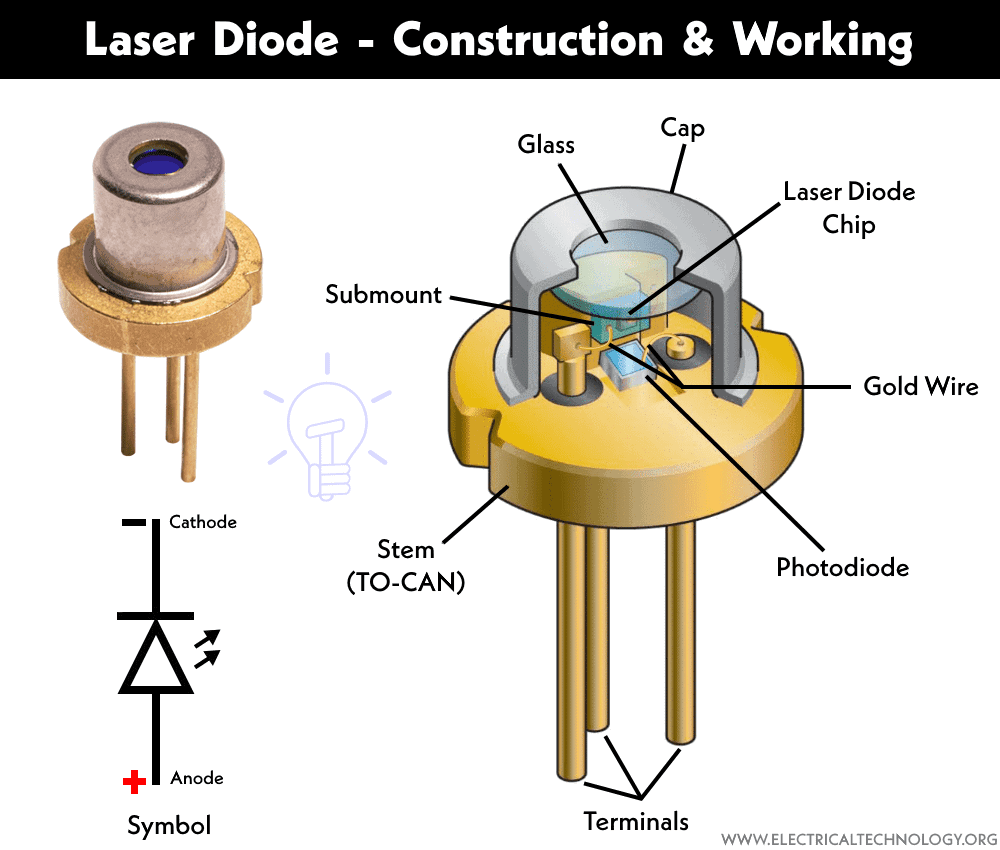
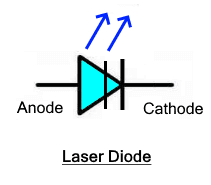
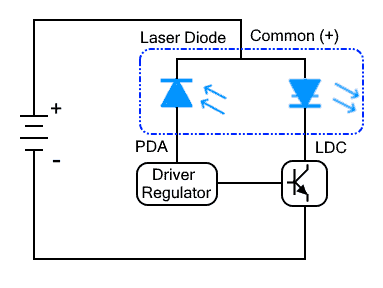

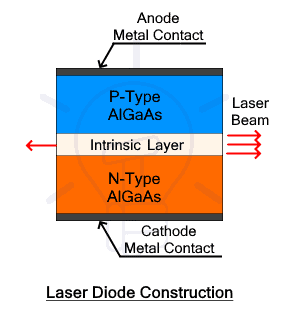
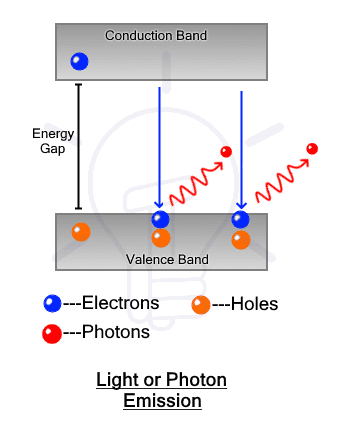







 Difference Between Edge Triggering and Level Triggering
Difference Between Edge Triggering and Level Triggering Difference between Zener Diode and Avalanche Diode
Difference between Zener Diode and Avalanche Diode Difference Between Amplifier and Operational Amplifier
Difference Between Amplifier and Operational Amplifier Difference Between Static RAM & Dynamic RAM – SRAM vs DRAM
Difference Between Static RAM & Dynamic RAM – SRAM vs DRAM Difference Between Digital Latch and Flip-Flop Circuits
Difference Between Digital Latch and Flip-Flop Circuits Difference Between Combinational and Sequential Logic Circuits
Difference Between Combinational and Sequential Logic Circuits